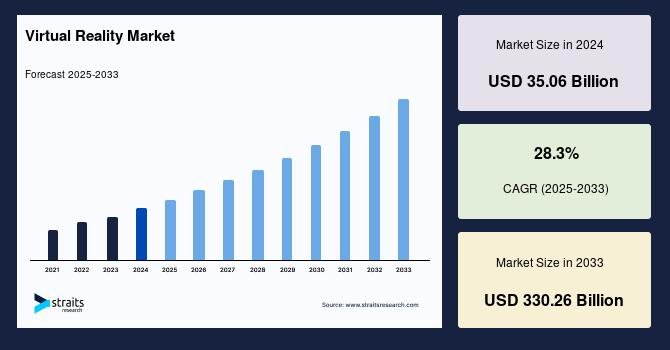According to Straits Research, the global virtual reality market size was valued at USD 35.06 billion in 2024 and is projected to reach USD 330.26 billion by 2033, growing at a CAGR of 28.3% during the forecast period (2025-2033). The surge in adoption of immersive technologies across sectors such as healthcare, gaming, education, defense, and retail is transforming VR from a niche innovation into a mainstream technological force.
Get more report insights: https://straitsresearch.com/report/virtual-reality-market
Virtual Reality Market Growth Driver
One of the primary forces propelling the virtual reality market is its increasing integration into healthcare applications. Virtual reality is revolutionizing patient care, medical training, and therapy by offering immersive, interactive simulations. Surgeons can now practice complex procedures in a controlled virtual environment, significantly reducing error rates and improving surgical outcomes. Additionally, VR has proven valuable in mental health treatment and rehabilitation, where virtual scenarios are used to help patients recover motor function or cope with phobias and trauma. The increasing focus on personalized and technology-driven healthcare solutions continues to drive VR adoption across hospitals, medical schools, and research institutions.
Beyond healthcare, the gaming and entertainment sectors remain the largest and fastest-growing contributors to the global VR ecosystem. The rising popularity of immersive experiences in video games, theme parks, and cinematic storytelling has driven developers and hardware manufacturers to invest heavily in next-generation VR hardware and content ecosystems. Affordable and wireless VR headsets, improved motion tracking, and 3D audio systems have made high-quality virtual experiences accessible to the mass market. As VR becomes more affordable and content-rich, its penetration across consumer segments is expected to deepen, further fueling market growth.
Market Segmentation
The global virtual reality (VR) market is segmented by device type, application, and technology, each driving significant growth across industries. By device type, head-mounted displays (HMDs) lead the market, supported by their versatility in consumer and enterprise applications. HMDs including hybrid, tethered, and standalone models are widely used for training in military, aerospace, engineering, research, and medical fields, offering interactive virtual experiences. Continuous technological advancements are enhancing immersion, fueling demand across various sectors.
By application, the commercial segment is the largest contributor, with VR adoption expanding in retail, real estate, and automotive industries. Businesses use VR headsets to showcase products, host virtual events, and engage consumers, as exemplified by AUDI AG’s virtual launch of the e-Tron Sportback. By technology, semi- and fully immersive VR dominates, replicating real-world environments on digital platforms using advanced simulators, high-resolution displays, and powerful computing. These solutions are increasingly applied in construction, aviation, entertainment, and automotive industries, enabling users to perform tasks and simulations that are otherwise impossible in traditional settings.
For more segmental analysis request a sample report: https://straitsresearch.com/report/virtual-reality-market/request-sample
Regional Analysis
North America currently leads the global virtual reality market, driven by strong digital infrastructure, high consumer spending, and early adoption across industries. The United States and Canada dominate the region with widespread use of VR in entertainment, healthcare, and defense training simulations. The presence of major players such as Meta Platforms, Microsoft, and Google fuels constant innovation and ecosystem development. Government and private investments in immersive technologies continue to enhance the region’s leadership position and accelerate enterprise-level adoption.
The Asia-Pacific region is expected to witness the fastest growth, supported by rapid urbanization, strong manufacturing capabilities, and government-led digital initiatives in China, Japan, South Korea, and India. Europe also remains a vital contributor, integrating VR into automotive, education, and industrial applications through its Industry 4.0 initiatives. Meanwhile, Latin America and the Middle East & Africa are gradually embracing VR, particularly in gaming, tourism, and real estate. As global connectivity and 5G infrastructure expand, these emerging regions are poised to significantly contribute to the global VR market’s future growth.
List of key players in Virtual Reality Market
Microsoft
Oculus
Google
Samsung Electronics
Sixense Enterprises
Leap Motion
Vuzix
Buy full report to access more report insights: https://straitsresearch.com/buy-now/virtual-reality-market
Conclusion
The global virtual reality market is on a trajectory of unprecedented growth, driven by rapid innovation, expanding use cases, and cross-industry adoption. With a forecast CAGR of 28.3% through 2033, VR technology is transitioning from entertainment to essential enterprise and educational applications. From healthcare and gaming to industrial training and retail engagement, VR’s ability to create immersive, data-driven experiences is redefining how people learn, work, and connect.
More Related Reports:
Location-Based Virtual Reality Market: https://straitsresearch.com/report/location-based-virtual-reality-market
Virtual Reality in Retail Market: https://straitsresearch.com/report/virtual-reality-in-retail-market
AR and VR Smart Glasses Market: https://straitsresearch.com/report/ar-and-vr-smart-glasses-market
Education Technology (EdTech) Market: https://straitsresearch.com/report/education-technology-market
Gaming Accessories Market: https://straitsresearch.com/report/gaming-accessories-market
Contact Us
Office 515 A, Amanora Chambers,
Amanora Park Town, Hadapsar,
Pune 411028, Maharashtra, India.
+1 646 905 0080 (U.S.)
+91 8087085354 (India)
+44 203 695 0070 (U.K.)
About Us
For over a decade, Straits Research has been a trusted partner to more than 2,000 small and large enterprises, empowering senior leaders and decision-makers with actionable intelligence to navigate complex markets. Our structured syndicate reports, published year-round, cover critical sectors such as chemicals, materials, food and beverage, healthcare, pharmaceuticals, automotive, technology, aerospace, and defense. Combined with our custom research tailored to client-specific needs, we deliver insights that drive business progress and informed decision-making.
This release was published on openPR.

















